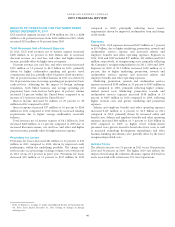American Express 2011 Annual Report Download - page 52
Download and view the complete annual report
Please find page 52 of the 2011 American Express annual report below. You can navigate through the pages in the report by either clicking on the pages listed below, or by using the keyword search tool below to find specific information within the annual report.AMERICAN EXPRESS COMPANY
2011 FINANCIAL REVIEW
CAUTIONARY NOTE REGARDING FORWARD-
LOOKING STATEMENTS
This report includes forward-looking statements within the
meaning of the Private Securities Litigation Reform Act of 1995,
which are subject to risks and uncertainties. The forward-looking
statements, which address the Company’s expected business and
financial performance, among other matters, contain words such
as “believe,” “expect,” “estimate,” “anticipate,” “optimistic,”
“intend,” “plan,” “aim,” “will,” “may,” “should,” “could,”
“would,” “likely,” and similar expressions. Readers are cautioned
not to place undue reliance on these forward-looking statements,
which speak only as of the date on which they are made. The
Company undertakes no obligation to update or revise any
forward-looking statements. Factors that could cause actual
results to differ materially from these forward-looking
statements, include, but are not limited to, the following:
폷changes in global economic and business conditions, including
consumer and business spending, the availability and cost of
credit, unemployment and political conditions, all of which
may significantly affect spending on American Express cards,
delinquency rates, loan balances and other aspects of the
Company’sbusinessandresultsofoperations;
폷changes in capital and credit market conditions, including
sovereign credit worthiness, which may significantly affect the
Company’s ability to meet its liquidity needs, access to capital
and cost of capital, including changes in interest rates; changes
in market conditions affecting the valuation of the Company’s
assets; or any reduction in the Company’s credit ratings or
those of its subsidiaries, which could materially increase the
cost and other terms of the Company’s funding, restrict its
access to the capital markets or result in contingent payments
under contracts;
폷litigation, such as class actions or proceedings brought by
governmental and regulatory agencies (including the lawsuit
filed against the Company by the U.S. Department of Justice
and certain state attorneys general), that could result in (i) the
imposition of behavioral remedies against the Company or the
Company voluntarily making certain changes to its business
practices, the effects of which in either case could have a
material adverse impact on the Company’s financial
performance; (ii) the imposition of substantial monetary
damages in private actions against the Company; and/or
(iii) damage to the Company’s global reputation and brand;
폷legal and regulatory developments wherever the Company
does business, including legislative and regulatory reforms in
the United States, such as the Dodd-Frank Reform Act’s
stricter regulation of large, interconnected financial
institutions, changes in requirements relating to securitization
and the establishment of the CFPB, which could make
fundamental changes to many of the Company’s business
practices or materially affect its capital requirements, results of
operations, or ability to pay dividends or repurchase its stock;
actions and potential future actions by the FDIC and credit
rating agencies applicable to securitization trusts, which could
impact the Company’s ABS program; or potential changes in
the federal tax system that could substantially alter, among
other things, the taxation of the Company’s international
businesses, the allowance of deductions for significant
expenses, or the incidence of consumption taxes on the
Company’s transactions, products and services;
폷the ability of the Company to generate its on-average and
over-time growth targets for revenues net of interest expense,
earnings per share and return on average equity, which will
depend on the factors such as the Company’s success in
implementing its strategies and initiatives, meeting its targets
for operating expenses and on factors outside management’s
control including changes in the economic and business
environment, the effectiveness of marketing and loyalty
programs, and the willingness of cardmembers to sustain
spending;
폷the Company’s net interest yield on U.S. cardmember loans
not remaining at historical levels, which will be influenced by,
among other things, the effects of the CARD Act (including
the regulations requiring the Company to periodically
reevaluate APR increases), interest rates, changes in consumer
behavior that affect loan balances, such as paydown rates, the
credit quality of the Company’s portfolio and the Company’s
cardmember acquisition strategy, product mix, cost of funds,
credit actions, including line size and other adjustments to
credit availability, and potential pricing changes;
폷changes in the substantial and increasing worldwide
competition in the payments industry, including competitive
pressure that may impact the prices the Company charges
merchants that accept the Company’s cards and the success of
marketing, promotion or rewards programs;
폷changes in technology or in the Company’s ability to protect
its intellectual property (such as copyrights, trademarks,
patents and controls on access and distribution), and invest in
and compete at the leading edge of technological
developments across the Company’s businesses, including
technology and intellectual property of third parties on whom
the Company relies, all of which could materially affect the
Company’s results of operations;
폷data breaches and fraudulent activity, which could damage the
Company’s brand, increase the Company’s costs or have
regulatory implications, and changes in regulation affecting
privacy and data security under federal, state and foreign law,
which could result in higher compliance and technology costs
to the Company or the Company’s vendors;
50
























